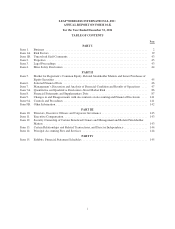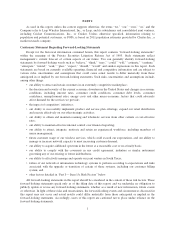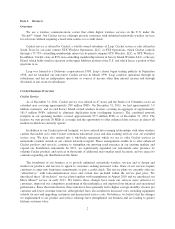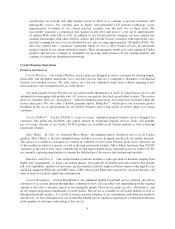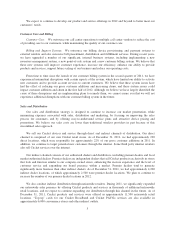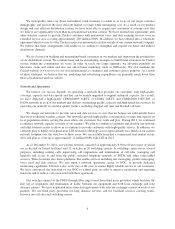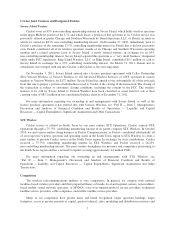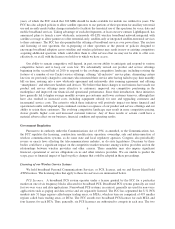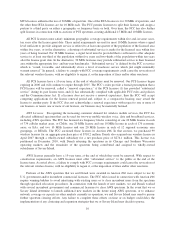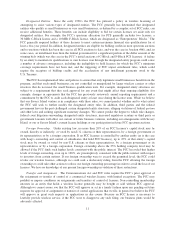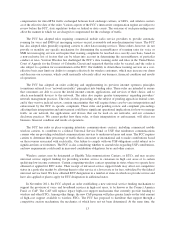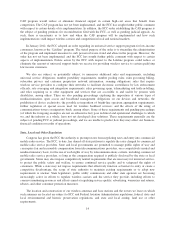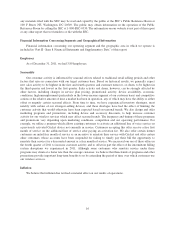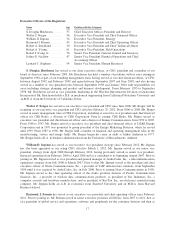Cricket Wireless 2011 Annual Report Download - page 18
Download and view the complete annual report
Please find page 18 of the 2011 Cricket Wireless annual report below. You can navigate through the pages in the report by either clicking on the pages listed below, or by using the keyword search tool below to find specific information within the annual report.established relationships with a larger base of current and potential customers. These advantages may allow our
competitors to provide service offerings with more extensive features and options than those we currently
provide, offer the latest and most popular devices through exclusive vendor arrangements, market to broader
customer segments and offer service over larger geographic areas than we can, offer bundled service offerings
which include landline phone, television and internet services that we are not able to duplicate, and purchase
equipment, supplies, devices and services at lower prices than we can. As device selection and pricing become
increasingly important to customers, any restriction on our ability to offer customers the latest and most popular
devices as a result of exclusive dealings between device manufacturers and our larger competitors could put us at
a significant competitive disadvantage and make it more difficult for us to attract and retain customers. In
addition, some of our competitors are able to offer their customers roaming services at lower rates. As
consolidation in the industry creates even larger competitors, advantages that our competitors may have, as well
as their bargaining power as wholesale providers of roaming services, may increase. For example, in connection
with the offering of our nationwide voice and data roaming services, we have encountered problems with certain
large wireless carriers in negotiating terms for roaming arrangements that we believe are reasonable, and we
believe that consolidation has contributed significantly to some carriers’ control over the terms and conditions of
wholesale roaming services.
The competitive pressures of the wireless telecommunications industry and the attractive growth prospects
in the prepaid segment have continued to increase and have caused a number of our competitors to offer
competitively-priced unlimited prepaid and postpaid service offerings or increasingly large bundles of minutes of
use at increasingly lower prices, which are competing with the predictable and unlimited Cricket Wireless service
plans. For example, AT&T, Sprint Nextel, T-Mobile and Verizon Wireless each now offer unlimited service
offerings. Sprint Nextel also offers competitively-priced unlimited service offerings under its Boost Unlimited
and Virgin Mobile brands, which are similar to our Cricket Wireless service. T-Mobile also offers an unlimited
plan that is competitively priced with our Cricket Wireless service. In addition, a number of MVNOs offer
competitively-priced service offerings. For example, Tracfone Wireless sells wireless offerings in Wal-Mart
under its “Straight Talk” brand using a number of other carriers’ wireless networks. We also face additional
competition in the prepaid segment from lifeline service offerings by competitors including Tracfone (through its
SafeLink offerings) and Sprint Nextel (through its Assurance Wireless offerings). Lifeline services are available
to consumers at reduced costs (and in some cases at no cost) because carriers offering this service receive a
subsidy payment from the federal Universal Service Fund program. Moreover, some competitors offer prepaid
wireless plans that are being advertised heavily to the same demographic segments we target. These various
service offerings have presented, and are expected to continue to present, strong competition in markets in which
our offerings overlap.
In addition to our voice offerings, many companies offer other products and services that compete with
those we offer. For example, there are numerous music services that compete with our Muve Music service,
including the iTunes service offered by Apple, Inc. and various streaming services offered by Rhapsody,
Pandora, Spotify and others. In addition, there are a number of mobile broadband services that compete with our
Cricket Broadband service, including those offered by AT&T, Sprint Nextel, T-Mobile and Verizon Wireless. In
addition, Clearwire Corporation has launched unlimited 4G wireless broadband service in a number of markets in
which we offer Cricket Broadband. Best Buy also offers a mobile broadband product using Sprint’s wireless
network. These service offerings have presented, and are expected to continue to present, strong competition in
markets in which our service offerings overlap.
We may also face additional competition from new entrants in the wireless marketplace, many of whom
may have significantly more resources than we do. The FCC is pursuing policies designed to increase the number
of wireless licenses and spectrum available for the provision of voice, data and mobile broadband services in
each of our markets, as well as policies to increase the level of intermodal broadband competition. For example,
the FCC has adopted rules that allow the partitioning, disaggregation and leasing of wireless licenses, which may
increase the number of our competitors. The FCC announced in March 2010, as part of its National Broadband
Plan, the goal of making an additional 500 MHz of spectrum available for broadband use within the next ten
8



